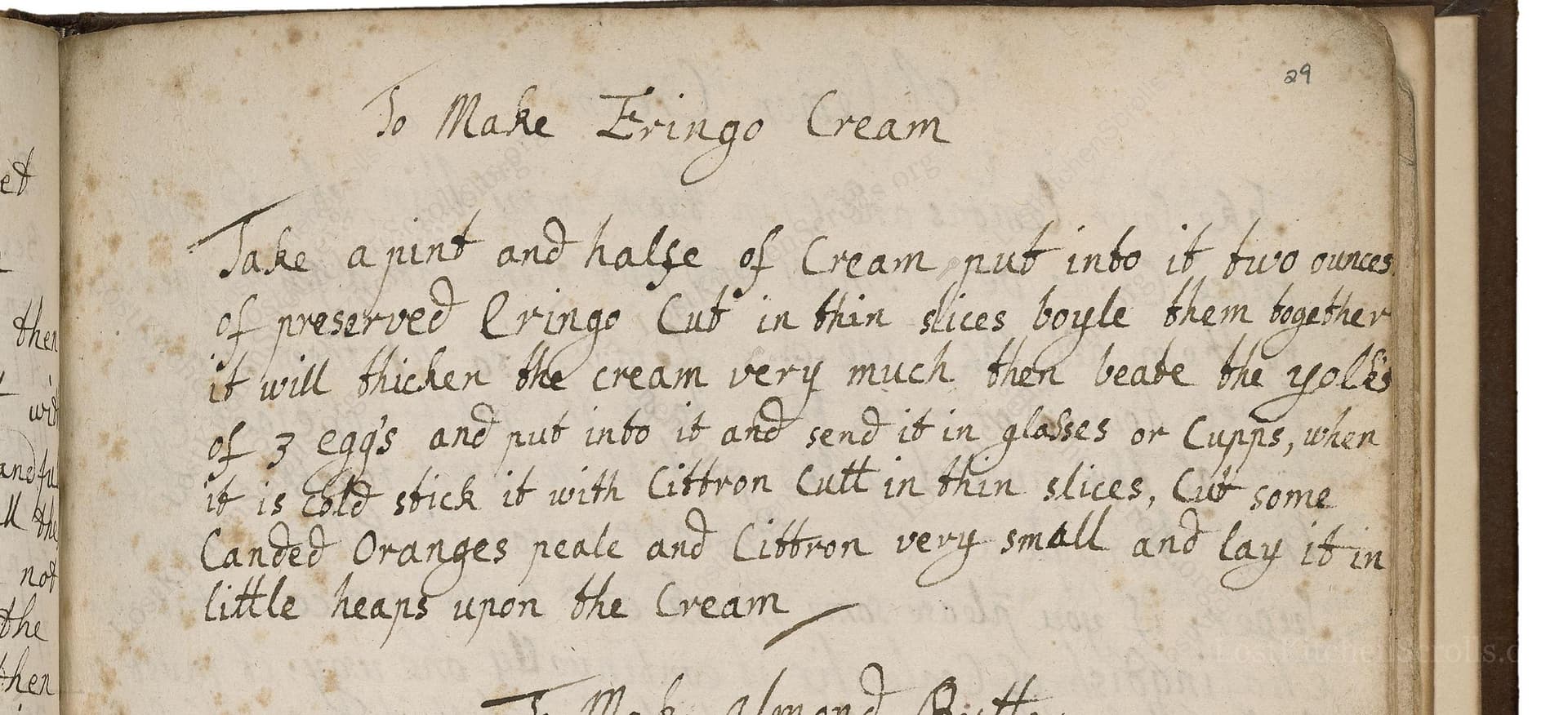To Make Eringo Cream
From the treasured pages of Receipt book
Unknown Author

To Make Eringo Cream
"Take a pint and halfe of Cream put into it two ounces of preserved Eringo Cut in thin slices boyle them together it will thicken the cream very much then beate the yolks of 3 eggs and put into it and send it in glasses or Cupps, when it is Cold stick it with Cittron Cutt in thin slices, Cut some Canded Oranges peale and Cittron very small and lay it in little heaps upon the Cream"
Note on the Original Text
Seventeenth- and early eighteenth-century recipes were written in narrative, sometimes seemingly stream-of-consciousness prose, presupposing a practiced cook's intuition for quantities and technique. 'Boyle' means to simmer gently, not reach a vigorous boil, while 'candied' and 'preserved' are terms used for sugar-preserved roots and fruits. Spelling such as 'Cittron', 'boyle', and 'peale' reflects phonetic or archaic standards; punctuation is sparse, and instructions blend process and presentation without separation—typical of the period’s culinary manuscripts.

Title
Receipt book (1700)
You can also click the book image above to peruse the original tome
Writer
Unknown
Era
1700
Publisher
Unknown
Background
A delightful glimpse into the kitchens of the early 18th century, this historic culinary manuscript promises a feast of recipes, remedies, and perhaps a pinch of mystery. Expect both practical fare and elegant inspiration for the curious cook.
Kindly made available by
Folger Shakespeare Library
This recipe comes from an English manuscript dated around 1700—a time when elaborate creams and syllabubs were a fashionable part of upper-class dining. Preserved 'Eringo' refers to candied roots of Eryngium maritimum, or sea holly, prized both for its delicate sweetness and its supposed medicinal virtues. Used in confectionery and desserts, it symbolized the innovative fusion of foreign spices, medicinal botanicals, and elegantly prepared creams that defined the late Stuart era’s courtly cuisine.

In the 1700s, this dessert would have been made using heavy-bottomed pans set over an open hearth or charcoal brazier. Mixing would be done with a wooden spoon or whisk, and eggs beaten by hand in earthenware or pewter bowls. The final cream was presented in clear glass or fine china cups, with sliced candied fruits arranged artistically atop—a testament to both culinary skill and refined hospitality.
Prep Time
10 mins
Cook Time
10 mins
Servings
6
We've done our best to adapt this historical recipe for modern kitchens, but some details may still need refinement. We warmly welcome feedback from fellow cooks and culinary historians — your insights support the entire community!
Ingredients
- 3 1/4 cups heavy cream
- 2 oz preserved eryngo root (substitute: preserved angelica root or candied ginger, if unavailable)
- 3 egg yolks
- Candied citron (to garnish, about 1 oz, sliced thin)
- Candied orange peel (to garnish, about 1/2 oz, finely chopped)
- Extra candied citron (to garnish, about 1/2 oz, finely chopped)
Instructions
- To recreate Eringo Cream in a modern kitchen, begin by pouring 3 1/4 cups of heavy cream into a saucepan.
- Slice 2 ounces of preserved eryngo root (or substitute with preserved angelica root or candied ginger for a similar effect) very thin and stir into the cream.
- Gently bring the mixture to a simmer, allowing it to thicken as the preserved root infuses—about 10 minutes.
- Lightly beat the yolks of 3 eggs in a separate bowl.
- Remove a small ladle of the hot cream and slowly whisk it into the eggs to temper them, then return the egg mixture to the saucepan, stirring constantly over gentle heat until it thickens but does not boil.
- Pour into glasses or small cups and let cool completely.
- Once set, top with thin slices of candied citron and arrange small piles of finely chopped candied orange peel and additional citron on the surface as garnish before serving.
Estimated Calories
390 per serving
Cooking Estimates
It takes about 10 minutes to cook the cream and root together. Preparing the ingredients and workspace, including slicing the roots and garnishes, and separating eggs, takes about 10 minutes. Each serving contains about 390 calories, and the recipe makes 6 servings.
As noted above, we have made our best effort to translate and adapt this historical recipe for modern kitchens, taking into account ingredients nowadays, cooking techniques, measurements, and so on. However, historical recipes often contain assumptions that require interpretation.
We'd love for anyone to help improve these adaptations. Community contributions are highly welcome. If you have suggestions, corrections, or cooking tips based on your experience with this recipe, please share them below.
Join the Discussion
Rate This Recipe
Dietary Preference
Culinary Technique

Den Bockfisch In Einer Fleisch Suppen Zu Kochen
This recipe hails from a German manuscript cookbook compiled in 1696, a time whe...

Die Grieß Nudlen Zumachen
This recipe comes from a rather mysterious manuscript cookbook, penned anonymous...

Ein Boudain
This recipe comes from an anonymous German-language manuscript cookbook from 169...

Ein Gesaltzen Citroni
This recipe, dating from 1696, comes from an extensive anonymous German cookbook...
Browse our complete collection of time-honored recipes



